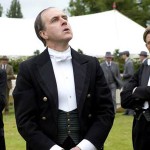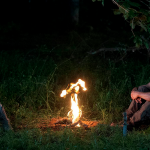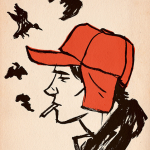Sometimes the best way to view the man behind the curtain is through the lens of the Fall.
“Quick! I’ll get the spray bottle!” My preschooler runs for the cupboard under the sink, where we store a plastic green spray bottle filled with water. It plays the key roles of keeping the cats off the kitchen table, untangling little girls’ hair, and defeating the Wicked Witch of the West.
You see, I do a (wicked) good impression of Margaret Hamilton from Victor Fleming’s The Wizard of Oz. My daughter races back from the kitchen, sprays me with the water, and I “melt,” busting out all of Hamilton’s lines in my best impersonation and finishing with the coup de grace “what a world!” as I crumple to the floor. Even the baby thinks this is all very entertaining. I am legitimately concerned that in a couple of years, this show is going to need to make room for a second Dorothy. In the meantime, I double as the Tin Man and the Wicked Witch while my elder child struts about in her glittery red shoes and directs the rest of the family in her endless revisions.
I only got the part of the Wicked Witch through sheer willpower, but I persisted because she is in my top-five, all-time favorite cinematic villains. Margaret Hamilton is masterful. So imagine my excitement upon hearing about the new Oz: The Great and Powerful, a film that fills in a back-story for some of the most memorable characters in literary and movie history. I liked Rachel Weisz and Zach Braff, as well as the intensely-colorful and exaggerated landscapes that paid homage to Fleming’s original film. But my praise ends there, and I left the theatre feeling like there were a lot of missed opportunities, particularly regarding the characterization and scripting of the witches. The film seems to believe in itself as a tale of good versus evil, but I read it instead as a story about the lies we tell ourselves about goodness and wickedness.
Take Evanora, played by Rachel Weisz. Only her remarkably naïve sister Theodora (Mila Kunis) seems to consider the possibility that she is good; for the purposes of the plot, Evanora is the obviously wicked witch, with no explanation for her evilness (other than her greed, thus, more wickedness) and no avenue for redemption. She murders her uncle to gain the throne, slaughters her subjects, and tricks her sister into eating a poisoned apple (wait, where have I seen that before?) and joining her reign of terror. In the end, Evanora pays the price for her misdeeds: she becomes a crone, because in Hollywood, nothing is more terrifying or terrible than an old, ugly woman. There is no ambivalence in Evanora’s evil.
Michelle Williams, meanwhile, takes on the role of Glinda, the witch Evanora and Theodora call “The Wicked Witch.” Yet Glinda convinces the wizard and his companions that she is really the good witch with no evidence and very little effort. She’s polite and pretty, and refers to the same conveniently-vague prophecy to persuade Oz and his friends to join her cause and fight to regain the throne from Evanora. Glinda’s magic consists mostly of white smoke and soap bubbles, and Williams lacks the stage presence of Billie Burke. It’s not that Glinda is evil, per se, but her Machiavellian schemes suggest a willingness to deceive and use her subjects to win back their kingdom. She’s less concerned with Oz being the prophesied wizard than she is with making him a mascot and rallying point for her war. It’s about appearances, not truth, and the film elides the two so much that audiences are asked to believe in the characters’ goodness with no indication of that trait. But perhaps the most frustrating aspect of Glinda is her insistence (in spite of his protests) that Oz is really a good man. Again and again she appeals to his better nature, something that he never demonstrates until the eleventh hour, and then only questionably. The relationship between Glinda and Oz reminded me of Flannery O’Connor’s short story “A Good Man Is Hard to Find,” where the grandmother talks incessantly to the criminal called The Misfit; she keeps telling him what a good man he is, in spite of his crimes, right up until he shoots her. Somehow I don’t see that kind of storyline working in a PG-rated Disney film, which is why audiences are reminded repeatedly to invest in Glinda’s goodness (just like the characters) even when her actions and intentions fail to match up.
Then there’s Theodora, who feels like an annoying rendition of Kunis’ Jackie character from That 70’s Show, but with none of her spunk. Theodora finds Oz first, and convinces herself within less than a day that they are made for each other and will rule the Emerald City together. It’s just that Oz never quite commits to these ideas, and Theodora comes across as pathetic, whiny, and naïve. It only gets worse as Theodora, scorned by Oz, accepts her sister’s evil apple and turns into the green-skinned, scantily-clad witch who prefigures Margaret Hamilton’s opus. I find it implausible and sad that the sister who most hoped for peace and unity in the realm is so easily destroyed because a huckster she’s known for a day spurns her. Hell hath no fury like a woman scorned, right? Yet again and again, we are told that Theodora is really still good. Sure she throws a lot of red fireballs around, but she penetrates the wall into Munchkinland, which only the good-hearted can do, and Oz offers her amnesty (which she promptly rejects) should she ever choose to return. It’s not really her fault she’s wicked. It’s her sister’s fault, or her circumstances—but her wholesale transformation into the verdant hag illustrates her commitment, her choice, to embrace wickedness.
It’s a bit baffling as well that at least two of these witches (again, kudos to Evanora for staying well out of it) find Oz attractive. James Franco plays the role like a too-slick salesman who’s overdosed on 5-Hour Energy. Lots of bravado, no substance. His helpfulness, like the help of the elder Wizard played by Frank Morgan, is all smoke and mirrors. Morgan’s wizard can’t bestow courage or love or brains; he can only offer superficial signifiers of what already exists within the recipients. That’s why, when it comes to real need, he is helpless, unable to send Dorothy back to Kansas. Franco’s wizard is equally impotent. It’s not that he does great things but that he stands on the shoulders of giants, the dedicated citizens who actualize his visions. More importantly, even if what Franco’s Oz achieves could be classified as greatness, goodness and greatness are not the same thing, nor are they degrees of the same thing. Oz is quite clear on that point: “I don’t want to be a good man… I want to be a great one.” He gains power through deceit, and we see from Victor Fleming’s film the way that trickery festers for decades.
In L. Frank Baum’s tale, the chapter where Dorothy and company meet the wizard is called “The Magical Art of the Great Humbug.” The Wizard admits, after expressing his impotence to help Dorothy return to Kansas, “How can I help being a humbug…when all these people make me do things that everybody knows can’t be done?” Yet in the previous chapter, Oz insists “I’m really a very good man; but I’m a very bad wizard.” Oz constructs an image of greatness and power that insulates him from harm and showers him with wealth and undeserved respect. He lies and swindles, using cheap tricks to give people what already belongs to them. He makes absurd demands of a child because he is too cowardly to risk his neck and his reputation (conveniently established to protect his image and power in the prequel) to kill the Wicked Witch himself. He rarely sees any of his subjects, and his interactions with them are marked by illusions that instill fear and bolster his powerful status. In what sense of the definition is this goodness? It reminds me of the scene in the Harry Potter series where the wandmaker Ollivander remarks “He-Who-Must-Not-Be-Named did great things—terrible, yes, but great.” Oz, too, is wonderful, great, and powerful, but good?
We know that Dorothy kills both wicked witches, accidentally of course, because she “is not a witch at all.” She’s a good-hearted little girl and a murderess. Reverse the roots of her name to find Theodora’s, and consider that both of their names mean “gift from God.” One is good and one is wicked. Or is it that both are wicked, and capable, by God’s gifts, to do good in spite of themselves? And this is where I can’t help but interpret the film through the Fall. Because the world cannot be divided into good witches, bad witches, and non-witches—though they can provide material for sublime storytelling. It’s that there’s a bit of wickedness in all of us, even though sometimes we, like Oz, manage to do the right thing at the right time in the right place. Like Oz, we may achieve greatness and power, and we may lie to ourselves about our deservedness, but behind every act of goodness is a sinner, weak and frail. We may choose to believe the smoke and mirrors, to accept the lie that winners are good-hearted and losers are wicked. But in that lie, there’s an implicit choice involved, one that begs us to pay no attention to that humbug behind the curtain.
Illustration courtesy of Seth T. Hahne. Check out his graphic novel and comic review site, Good Ok Bad.












